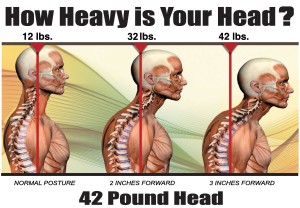Do You Have Computer Neck?
Do you suffer from computer neck? Have you ever heard of computer neck? What the heck is computer neck anyway?
Computer neck, also known as anterior head carriage, is a postural distortion. If you look at a person from the side, and you see their head is in front
of their shoulders, they have computer neck.
Ideally, we carry our head squarely over our shoulders where it can be supported by our spinal column, with very little effort by our muscles.
In anterior head carriage, or computer neck, we carry our head out in front of our shoulders. As our head moves forward, gravity tries to
pull it down. In order to keep our head off our chest, our posterior neck and upper back muscles must work hard to hold it up. With gravity
exerting its' pull, our head can weigh as much as 42 pounds!

Increasingly, many of our activities put us into an anterior head carriage. Examples include siting at a desk to write or type. We move our head forward to see
the paper we are writing on, or to look at the keyboard we are typing on. When we sit down to eat, our head moves forward as we bring food to our mouth. The
headrests in our cars push our head forward. Our recliner chairs push our head forward. The list gets longer, but I think you get the idea.
Our ligaments are the structures responsible for holding our bones together in correct alignment. When ligaments fail to do their job, either from damage,
such as sprains, or because the are overpowered by our muscles, bones move into incorrect alignment.
So what's wrong with our heads in a forward position?
With our heads carried in a forward position, the posterior neck and upper back muscles must work extra hard against the pull of gravity. In time these muscles
become fatigued and symptoms may develop, such as tight achy muscles, headache, and restricted range of motion. After prolonged periods held in this position,
our brain thinks we want to keep our head forward, and will shorten the anterior neck and upper chest wall muscles to keep our head in this forward position.
At that point, we are unable to adopt correct posture. Of course, anytime a muscle or group of muscles changes its length and tone, the rest of the body must
accommodate the change and compensate. Just as when you squeeze on end of an inflated balloon, the shape of the whole balloon changes. Over time, this leads
to more postural distortions and complications, compromising body functions and our overall comfort.
So, what can be done about computer neck?
If you have computer neck, or know someone with computer neck, don't despair.
Myoskeletal Alignment Technique offers help and relief from symptoms with specific techniques to address and correct anterior head carriage, or computer neck.
Shortened muscles are lengthened, inhibited muscles, or those muscles that are stretched tight, are returned to their correct length and tone, and the head
and neck are brought back over the shoulders where they belong.
I am a certified Level 4 Myoskeletal Alignment Technique therapist. If you suffer from computer neck, or think you may have computer neck, why not call for an appointment,
or for a free consultation?